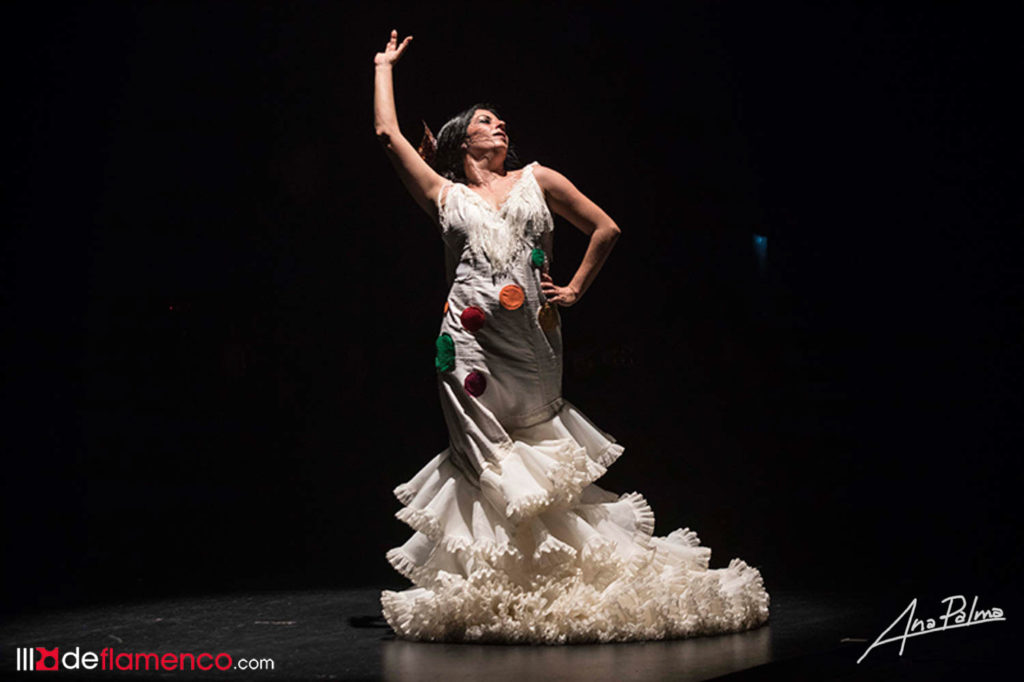24th FESTIVAL DE JEREZ
Monday, March 2nd, 2020
MERCEDES DE CÓRDOBA “Ser, ni conmigo ni sin mí”
Teatro Villamarta, 9:00pm
Photo gallery – video
Dance: Mercedes de Córdoba. Guitar: Juan Campallo. Voice: Enrique el Extremeño, Antonio Núñez “El Pulga”, Jesús Corbacho. Percussion: Paco Vega. Artistic director: Ángel Rojas
Mercedes de Córdoba, holder of the National Dance Prize of Córdoba, had her night at the Villamarta Theater within the framework of the Festival de Jerez.
I’d seen Mercedes in dance companies, particularly that of Eva Yerbabuena, whose influence clearly shows in her work, not only in her style of dance, but in the way her work is constructed. First, darkness, slowness and a conceptual line, for a very long time, and towards the end of the show, generous doses of flamenco with a magnificent soleá, but oddly enough, while leaving the theater I heard a young woman with a Madrid accent say “I loved the whole show except for the soleá”. It shows the rift between generations as far as flamenco dance goes.
Beautiful communication with singer Enrique el Extremeño in the stylized taranto. And darkness, always the darkness. The dance ends, I blink, and the dancer seems to disappear as if by magic, a surprising effect.
An enormous cross of several meters is hanging from the ceiling, but I couldn’t figure out hits meaning. Perhaps it’s best not to seek the meaning of things in this flamenco dream world.
The dancer is seen to be in a café, singer Jesús Corbacho opens the door to free her and Mercedes dances caracoles with a long white train dress, and there is light and optimism. For yours truly, it was hard to relate the long conceptual segment with conventional flamenco dance, but I was grateful for the sensorial stimulus, and the effusive audience reaction confirmed they felt the same. Then the dance ends, Mercedes pulls off the large polkadots attached to her dress and I feel like a naughty child for having allowed myself to be carried away by the cliché of polkadots (said with irony).
The dancer drags herself across the full length of the floor (and all mothers present wondered who woiuld be in charge of washing the white dress), but she’s saved by compás and much twirling of her shawl. Another memorable scene comes when the guitarist, Juan Campallo, embraces the dancer from behind while she supports the guitar, with the two becoming one person with the instrument as a single entity.
The above-mentioned soleá is full of power and drama, and a contemporary style that reflects classic flamenco. Jesús Corbacho and El Pulga, admirable voices that compete the trio of singers with excellent work.
MARÍA VARGAS
Palacio Villavicencio, 6:00pm
Photo gallery / video
Before reading what I have to say about yesterday’s recital of María Vargas Fernández, the singer from Sanlúcar, I have to confess that María and I are good friends. Or perhaps for that precise reason I’m able to communicate the essence of her life and work.
At the age of fifteen she was named “Catedrática del Cante Gitano” by the Cátedra de Flamencología of Jerez, and just recently she was awarded Spain’s Gold Medal for the Arts, 2019. That’s about six decades between one prize and the other, and dozens of plaques, trophies and diplomas fill María’s house in the San Miguel neighborhood.
A year and a half ago, she moved to Jerez after living many years in Madrid. María is a sweet older lady with no trace of the typical star’s ego, as well as a wonderful cook. Friends and admirers call her “Tata”, an affectionate nickname.
That same Maria, so sweet and mild-mannered, can twist you inside-out with her siguiriya when she’s led by the remembered voice of her father Manuel, grandson of Tomás el Nitri. She is transformed and enters a state of flamenco grace, you’re taken on a trip straight to a kind of flamenco singing from an earlier era, but which is eternally relevant, because human emotions have no expiration date.
Martinete, romeras, bulería por soleá, siguiriyas (ay, that hospitalito verse!), tientos tangos, fandangos and bulerías with the guitar of Miguel Salado and the rhythm of Israel López and Miguel el Palmero. The audience was warm, grateful and moved. As was I.
